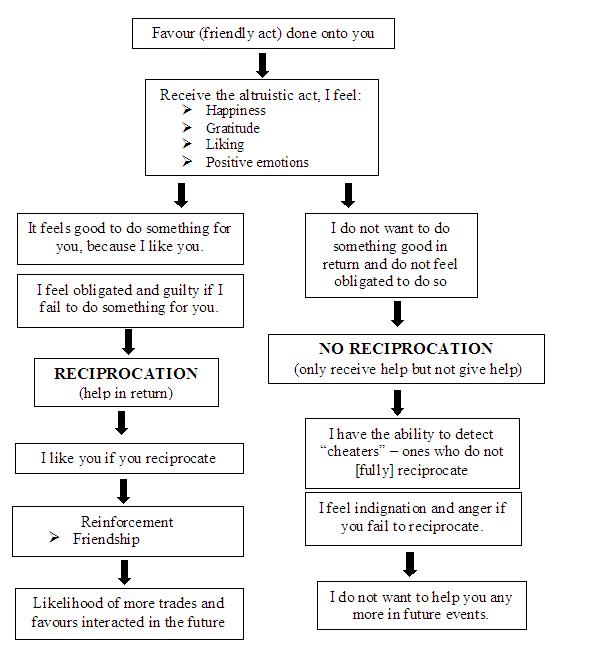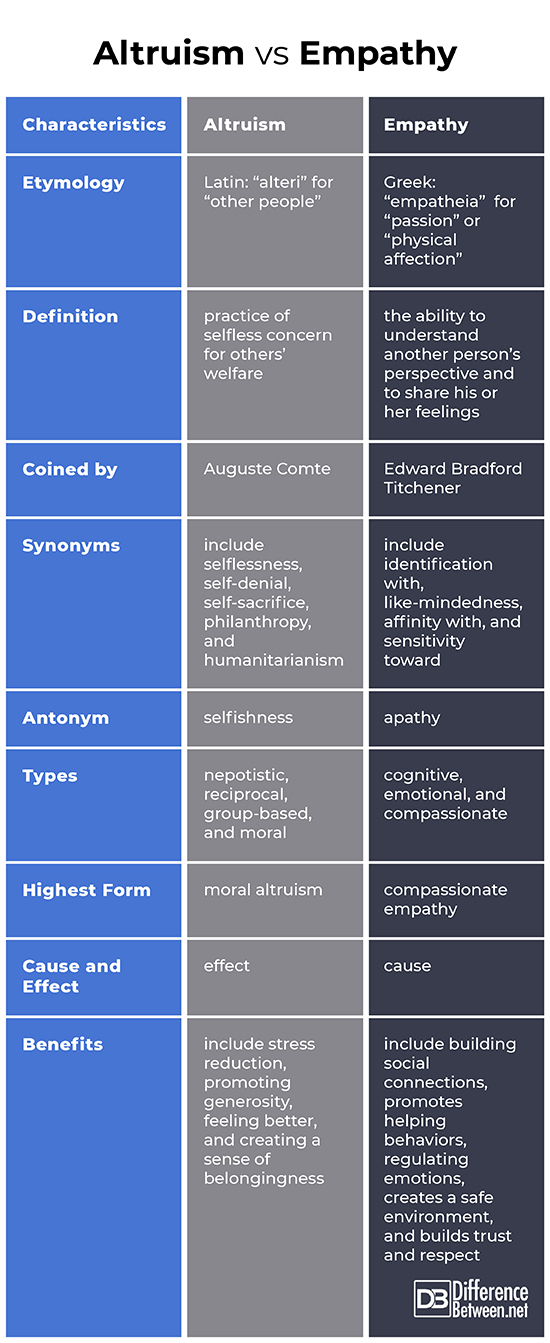Difference Between Altruism and Empathy
Altruism and empathy generally go together since you often need to empathize with others first before you perform altruistic acts. For instance, the empathy-altruism hypothesis states that the key ingredient for being helpful is empathic concern. According to research, both values may also be taught. For example, mindfulness, socio-affective skills training, and cognitive flexibility courses have been shown to increase prosocial behavior which are related with empathy and altruism.
Regarding their distinctions, altruism is the moral practice of having concern for others’ wellbeing while empathy is the capacity to feel or understand what others are going through. The former is concerned with the action while the latter is more involved with the affective and cognitive aspects. The following discussions further delve into these differences.

What is Altruism?
Altruism came from the Latin word “alteri” which means “other people”; it is the practice of selfless concern for others’ welfare. This was coined by August Comte, a French philosopher, in the 19th century. Its synonyms include selflessness, self-denial, self-sacrifice, philanthropy, and humanitarianism. Its opposite is egoism or selfishness which is having more concern for oneself than others. Altruism is a traditional virtue in most (if not all) cultures as it is inherent for humans to show concern for other beings.
Altruism has four types: nepotistic, reciprocal, group-based, and moral.
- Nepotistic altruism is family-based, for instance, a mother is sacrificing her career to care for her child.
- Reciprocal altruism or mutualism is based on the give and take relationship. For instance, when a friend helped you during a financial crisis, you also more than willingly lent him money when he was in need.
- Group-based altruism is helping a fellow member; for instance, an athlete is sharing his last bottle of water with his team mates who are thirsty.
- Moral altruism is the highest form since it is a direct concern for another individual, whoever he may be. For instance, a philanthropist is helping anyone who is in need, not because someone is a relative or because of a previous relationship. An iconic example is the “Good Samaritan” who helped someone who is supposed to be treated as an adversary.

What is Empathy?
Empathy came from the Greek word “empatheia” which means “passion” or “physical affection”. It is the ability to understand another person’s perspective and to share his or her feelings. Its synonyms include identification with, like-mindedness, affinity with, and sensitivity toward. The term “empathy” was then popularized by Edward Titchener, an American psychologist, in 1909.
Empathy has three types: cognitive, emotional, and compassionate.
- Cognitive empathy, sometimes termed as perspective-taking, is knowing what the other individual is feeling and thinking. This is helpful in understanding others’ perspectives.
- Emotional empathy is being able to feel what the other person is feeling. This usually occurs in intimate relationships.
- Compassionate empathy is the highest form since it combines the previous ones and leads to altruistic behaviors. It is being able to emotionally and cognitively relate to someone’s predicament which fuels noble deeds.
Difference between Altruism and Empathy
Etymology
Altruism came from the Latin word “alteri” which means “other people” while empathy came from the Greek word “empatheia” which means “passion” or “physical affection”.
Definition
Altruism is the practice of selfless concern for others’ welfare while empathy is the ability to understand another person’s perspective and to share his or her feelings.
Coined by
In the 19th century the term altruism was coined by August Comte, a French philosopher. In comparison, in 1909, empathy was translated by Edward Titchener, an American psychologist, from “einfuhlung” an old German concept which means “feeling into” the natural world.
Synonyms
The synonyms of altruism include selflessness, self-denial, self-sacrifice, philanthropy, and humanitarianism. On the other hand, those of empathy include identification with, like-mindedness, affinity with, and sensitivity toward.
Antonym
The opposite of altruism is selfishness while that of empathy is apathy.
Types
Altruism has four types: nepotistic, reciprocal, group-based, and moral. As for empathy, it has three types: cognitive, emotional, and compassionate.
Highest Form
The highest form of altruism is “moral” since it is having a direct concern for anyone no matter who he or she is. As for empathy, its highest form is compassionate since it combines the previous ones and leads to altruistic behaviors.
Cause and Effect
Ideally, the cause is empathy as one first needs to relate to another person’s predicament before displaying altruism (which is the effect).
Benefits
The benefits of altruism include stress reduction, promoting generosity, feeling better, and creating a sense of belongingness. As for empathy, the benefits include building social connections, promoting helping behaviors, regulating emotions, creating a safe environment, and building trust and respect.
Altruism vs Empathy

Summary
- Altruism came from the Latin word “alteri” which means “other people” while empathy came from the Greek word “empatheia” which means “passion” or “physical affection”.
- The term altruism was coined by August Comte while empathy was translated by Edward Titchener.
- Altruism has four types: nepotistic, reciprocal, group-based, and moral. As for empathy, it has three types: cognitive, emotional, and compassionate.
- Ideally, the cause is empathy and the effect is altruism.
- The benefits of altruism include stress reduction, promoting generosity, feeling better, and creating a sense of belongingness while those of empathy include building social connections, promoting helping behaviors, regulating emotions, creating a safe environment, and building respect.
- Difference Between Hematoma and Melanoma - February 9, 2023
- Difference Between Bruising and Necrosis - February 8, 2023
- Difference Between Brain Hematoma and Brain Hemorrhage - February 8, 2023
Search DifferenceBetween.net :
Leave a Response
References :
[0]Image credit: https://live.staticflickr.com/3728/11984559914_7bf4545c04_b.jpg
[1]Image credit: https://commons.wikimedia.org/wiki/File:Reciprocal_altruism.jpg
[2]McLaren, Karla. The art of empathy. Boulder, CO: Sounds True, 2013. Print.
[3]Patnaik, Dev. Wired to care. San Mateo, CA: Jump Associates, 2009. Print.
[4]Ricard, Matthieu. Altruism. NY, New York: Little, Brown and Company, 2015. Print
